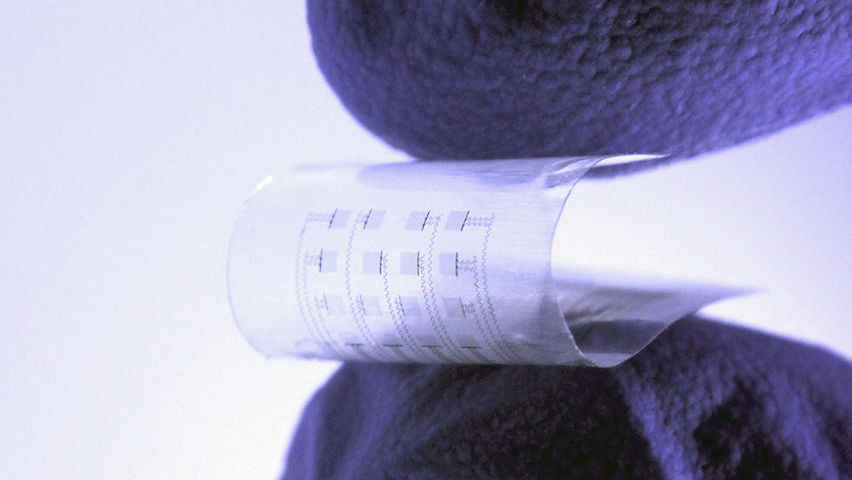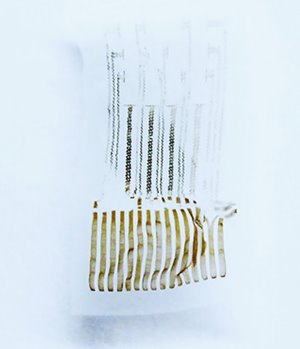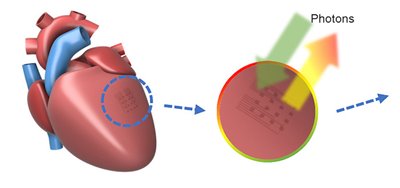Stamp-Like Device Treats Heart Disease, Then Dissolves
Stamp-Like Device Treats Heart Disease, Then Dissolves


Treating and monitoring heart disease could soon be as simple as adhering a thin, bioabsorbable patch onto the heart.
Treating heart disease and dysfunction has long been an invasive task, involving complicated surgeries and installation of devices such as pacemakers. But a team of researchers at Northwestern University and George Washington University have a solution in the form of a soft, flexible patch-like device that can both monitor and treat heart disease, then dissolve once it’s served its purpose.
To do that, this device uses an array of sensors and actuators to perform more complicated investigations than traditional devices like pacemakers, all while being just the size of a typical postage stamp.
“Soft, bioresorbable, transparent microelectrode arrays for multimodal spatiotemporal mapping and modulation of cardiac physiology,” outlining the team’s findings, was published July 5 in the journal Science Advances.
“Our device has several important features by design. Firstly, it is a mechanically conformal device, that is, it seamlessly conforms to the soft contracting cardiac muscle without affecting its biological or mechanical function," explained Igor Efimov, an experimental cardiologist who co-led the study, a professor of biomedical engineering at Northwestern’s McCormick School of Engineering, and a professor of medicine at Northwestern University Feinberg School of Medicine. “Previous metal devices were not sufficiently compliant, causing obstruction or damage to the heart muscle. Secondly, it is an electronic device that is capable of capturing electromagnetic energy from a nearly high-frequency transmitter through its antenna, extracting a waveform and delivering it to the heart as a stimulus.”
More for You: Plant Burrs Inspire Strong Sutures for Soft Tendons
This allows the device to restore normal heart rhythms. It can also sense an electrogram from nearby heart muscle and transmit it to a recording interface, helping show which areas of the heart are functioning well and which are not. Its flexibility means the device can be put on several different sections of the heart, while streaming continuous information to doctors who can observe and monitor a patient’s heart in real time.
"Thirdly, this electro-mechanical device is optically transparent because we aim to add another layer to it, which will allow using light for optical stimulation or imaging of the heart muscle to gain information about its biology,” Efimov said.
A culmination
Creating such a device combines years of work across several fields. First was a simple, tiny implantable pacemaker in 2013 that didn’t have a battery and was controlled by an external electromagnetic field via an inductive power transfer. That first attempt failed because of a mechanical mismatch between the soft cardiac tissue and stiff pacemaker materials, Efimov explained.
So, he began looking for advances in materials science that could help. Around this time, the Institute of Electrical and Electronics Engineers asked Efimov to organize a session on novel approaches to bioelectronics. “During this work on the session, I came across several amazing names in bioelectronics, including Dr. [John] Rogers. I chaired the session I organized, and after an eye-opening talk with Dr. Rogers, I asked him if he was interested in collaborating to translate his work to the field of cardiovascular medicine. We have been collaborating ever since."
Become a Member: How to Join ASME
Rogers, the Louis Simpson and Kimberly Querrey professor of materials science and engineering, biomedical engineering and neurological surgery at Northwestern, and his team of material scientists developed new materials and fabrication methods required to build mechanically conformal soft bioelectronics. “This was the foundation of a tiny implantable pacemaker without a battery and wires, controlled by a wearable device with inductive power transfer,” Efimov said. “The next step was to develop a bioresorbable version, such as a pacemaker, and a wearable device to control it.”
The team published their work on this next iteration in 2022, then partnered with Dr. Luyao Lu, then Rogers’ trainee and now an assistant professor of biomedical engineering at George Washington University and co-led the latest study with Efimov. With Lu's help, the team further scaled up their effort and built an array of sensors and actuators to serve as a backbone for various temporary diagnostic and therapeutic devices. Lu’s experience as an optical engineer also helped the team achieve the device’s optical transparency.
To attach the device to the heart muscle or even other organs, Rogers’ materials science team developed a bioadhesive with fast mechanical adhesion, proper electrical conductance, optical transparency, and bioresorbable chemistry.
Cyborgs ahead
“According to one of the definitions, a cyborg is a person whose biology is aided by an implantable electronic device. Cyborgs have existed since the 1950-60s, when implantable pacemakers become a reality," Efimov said. “However, electronic devices do not yet have the ability to self-repair, unlike biological systems.”
Because of that, some patients with pacemakers actually still have broken wires in their blood vessels that belonged to pacemakers that have since been removed. Removing those wires isn’t always possible, as connective tissue will grow around them, Efimov added.
"Our technology addresses this problem. Bioresorbable or transient electronics are designed to serve a required period and dissolve after that without adverse effects on the patient. Such devices will serve as implantable pacemakers, defibrillators, monitors of various kinds, or could augment a function for some period,” he explained.
Similar Reading: Smart Coatings on Implants Transmit Health Data in Real Time
The device is comprised of materials that are already FDA-approved and used in dissolvable medical devices today, such as surgical sutures or stents. This fact alone could help reduce healthcare costs and improve patient outcomes by avoiding complications from surgical extraction and lowering infection risks.
Efimov’s team has numerous ideas on organic conformal soft electronic devices that can be applied for the diagnosis and treatment of cardiovascular, neurological, muscular-skeletal, and other diseases. “We also think about transient electronic devices that could serve as temporary monitors after life-saving surgeries or procedures or during recovery after life-threatening diseases, such as COVID," he said. “Fortunately, there is much interest from funding agencies and investors. This year alone, we received several new grants from the National Institutes of Health and from the Leducq Foundation, which funded us in the past as well. “
The potential for mechanically soft bioelectronics is vast and could bring about new ways of monitoring or treating illnesses, all without the need for surgical removal of unwanted or malfunctioning devices.
“By combining organ-conformal bioresorbable devices with wearable devices and machine learning or artificial intelligence, decision-making systems will not only transform medicine but also create novel approaches to healthy lifestyles and longevity,” Efimov added.
Louise Poirier is senior editor.





.png?width=854&height=480&ext=.png)


